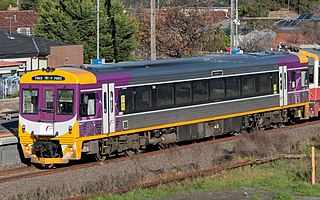The South Gippsland Railway was a tourist railway located in South Gippsland, Victoria, Australia. It controlled a section of the former South Gippsland railway line between Nyora and Leongatha, and operated services from Leongatha to Nyora, via Korumburra, the journey taking about 65 minutes.
Railmotor is a term used in the United Kingdom and elsewhere for a railway lightweight railcar, usually consisting of a railway carriage with a steam traction unit, or a diesel or petrol engine, integrated into it.
The railways of New South Wales, Australia, use a large variety of passenger and freight rolling stock. The first railway in Sydney was opened in 1855 between Sydney and Granville, now a suburb of Sydney but then a major agricultural centre. The railway formed the basis of the New South Wales Government Railways. Passenger and freight services were operated from the beginning. By 1880, there was a half hourly service to Homebush.

The N Class are a class of diesel locomotives built by Clyde Engineering in Somerton for V/Line between 1985 and 1987.

The Diesel Electric Rail Motor (DERM) was a type of railmotor operated by the Victorian Railways in Australia.

The Sprinter is a diesel railcar built by A Goninan & Co in Broadmeadow, NSW for V/Line between 1993 and 1995.

The H type carriages are a class of interurban passenger carriage operated by V/Line in Victoria, Australia. Fitted with high-density 2+3 seating, they were typically used on short distance interurban services from Melbourne to Bacchus Marsh and Geelong until their withdrawal in 2024.
The MT type carriages were railmotor trailers, used on the Victorian Railways (VR) in Australia.
The New Deal for Country Passengers was a timetable introduced on 4 October 1981 in Victoria, Australia which revolutionised the provision of country passenger railway services in that state. Thirty-five little-used passenger stations were closed, rolling stock utilisation was improved, and new rolling stock introduced. The timetable and associated service changes resulted in an average patronage growth of 8.7% per year, from 3 million in 1981 to 5.6 million passengers in 1990/91.

The family of Walker railmotors were a type of diesel railcar operated by the Victorian Railways in Australia.

The 900/800 class railcars were diesel multiple units built by the New South Wales Government Railways between November 1951 and November 1960.

Tulloch Limited was an Australian engineering and railway rolling stock manufacturer, located at Rhodes, New South Wales.

Two models of South Australian Railways Brill railcar operated by the South Australian Railways between 1925 and 1971. Introduced to run on country rail services, the "Barwell Bulls" serviced most of the state's railway lines until they were eventually replaced by both the Bluebird and Redhen railcars. The last units were withdrawn in 1971.
The 660 & 760 class railcars are a class of diesel multiple unit train built by the New South Wales Government Railways (NSWGR) and used in the latter stages of their life by CityRail, primarily on its Hunter Valley line. The trains have since been phased out in favour of the newer Endeavour railcar model. The 660/760 railcars were converted by NSWGR from earlier 600/700 Class vehicles between 1973 and 1975.

The South Coast Daylight Express was a limited stops passenger train operated by the New South Wales Government Railways and its successors between Sydney and Bomaderry from 1933 until January 1991.
The 1100 class railcar or Budd railcar were a type of diesel railcar built by Commonwealth Engineering for the Department of Railways New South Wales in 1961. They primarily operated on the South Coast Daylight Express until withdrawn in 1993.

The 1200 class railcar or Tulloch railcar were a type of diesel railcar built by Tulloch Limited for the New South Wales railways department between June 1970 and May 1972. They were built to operate the Riverina Express before being transferred to the South Coast Daylight Express.
The R type carriages were a series of locomotive-hauled carriages proposed to be built for the Victorian country rail network in the early and mid 1980s.


















